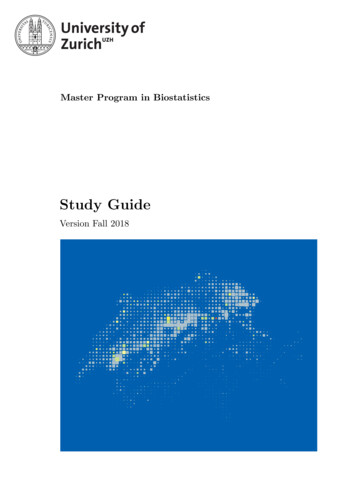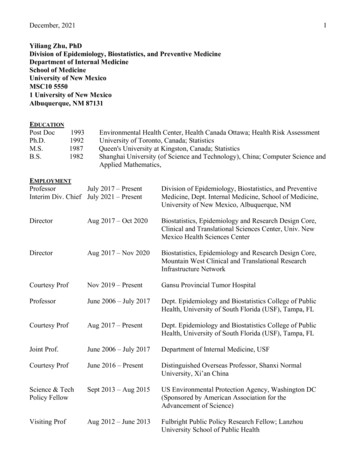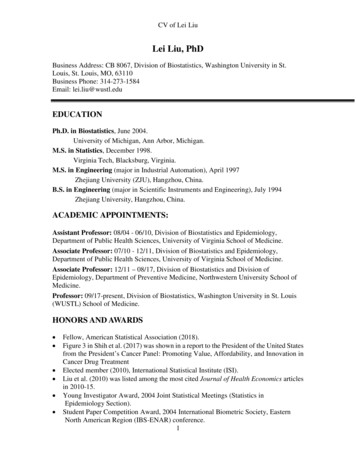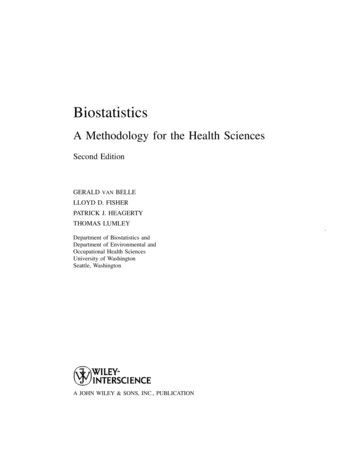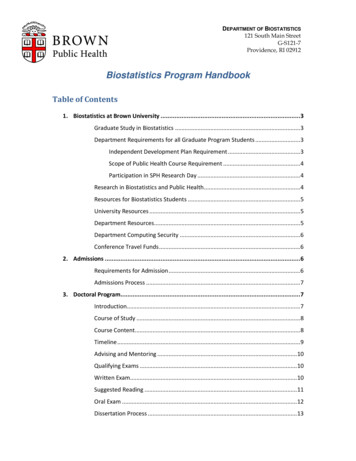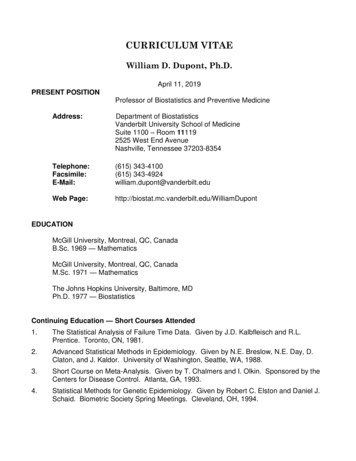
Transcription
Lectures of Stat -145(Biostatistics)Text bookBiostatisticsBasic Concepts and Methodology for the Health SciencesByWayne W. Daniel
Chapter 1Introduction ToBiostatisticsText Book : Basic Concepts andMethodology for the HealthSciences2
Key words : Statistics , data , Biostatistics,Variable ,Population ,SampleAfter studying this chapter, the student will be able to:1- understand the basic concepts and terminology of biostatistics.2-select random sample and the processes involved in scientific anddesign of experiments .3- organize summarize and presentation of data Text Book : Basic Concepts andMethodology for the HealthSciences3
IntroductionSome Basic conceptsStatistics is a field of study concernedwith1- collection, organization, summarizationand analysis of data.2- drawing of inferences about a body ofdata when only a part of the data isobserved.Statisticians try to interpret andcommunicate the results to others.Text Book : Basic Conceptsand Methodology for the HealthSciences4
Statistics:Statistics is that area of study which isinterested in learning how to collect, organize,and summarize information, and how toanswer research questions and drawconclusions. In other word: a set of tools for collection,organizing, presentation and analyzing ofnumerical facts or observations.Text Book : Basic Conceptsand Methodology for the Health5
* Biostatistics:The tools of statistics are employed inmany fields:business, education, psychology,agriculture, economics, etc.When the data analyzed are derived fromthe biological science and medicine,we use the term biostatistics todistinguish this particular application ofstatistical tools and concepts.Text Book : Basic Conceptsand Methodology for the Health6
Biostatistics:If the information is obtained frombiological and medical sciences, then weuse the term biostatistics. i.e. the application of statistical methods tosolution of biological problems.Text Book : Basic Conceptsand Methodology for the Health7
Data: The raw material of Statistics is data. We may define data as figures. Figuresresult from the process of counting orfrom taking a measurement. For example: - When a hospital administrator countsthe number of patients (counting). - When a nurse weighs a patient(measurement)Text Book : Basic Conceptsand Methodology for the Health8
* Sources of Data:We search for suitable data to serve asthe raw material for our investigation.Such data are available from one or moreof the following sources:1- Routinely kept records.For example:- Hospital medical records containimmense amounts of information onpatients.- Hospital accounting records contain awealth of data on the facility’s businessactivities.Text Book : Basic Conceptsand Methodology for the Health9
Sources of Data:2- Surveys:The source may be a survey, if the dataneeded is about answering certainquestions.For example:If the administrator of a clinic wishes toobtain information regarding the mode oftransportation used by patients to visitthe clinic,then a survey may be conducted amongBook : BasicthisConcepts information.10patients toandTextobtainMethodology for the Health
Sources of Data:3- Experiments.Frequently the data needed to answera question are available only as theresult of an experiment.For example:If a nurse wishes to know which of severalstrategies is best for maximizing patientcompliance,she might conduct an experiment in which thedifferent strategies of motivating complianceText Book: Basic Concepts patients.11are tried withdifferentand Methodology for the Health
Sources of Data:4- External sources.The data needed to answer a question mayalready exist in the form ofpublished reports, commercially availabledata banks, or the research literature,i.e. someone else has already asked thesame question.Text Book : Basic Conceptsand Methodology for the Health12
In other word we can view the sources of data as Historicaland Field data, for example Past information (record) abouta company, patient used to help forecast the future; forexample, historical price. While the field data can be collect as instantenouns , likepatient temperature during inspection, blood pressure andText Book : Basic Conceptsand Methodology for the Health13
* A variable:It is a characteristic that takes ondifferent values in different persons,places, or things.For example:-heart rate,the heights of adult males,the weights of preschool children,the ages of patients seen in a dentalclinic.Text Book : Basic Conceptsand Methodology for the Health14
Types of variablesQuantitativeQualitativeQuantitative Variables Qualitative VariablesIt can be measured Many characteristics arein the usual sense.not capable of beingFor example:measured. Some of themcan be ordered (calledordinal) and Some ofthem can’t be ordered(called nominal).- the heights ofadult males,- the weights ofpreschool children,For example:- the ages ofpatients seen in a - classification of peopledental clinic.socio-economic groups(ordinal),Text Book : Basic Concepts-.hairforcolor(nominal)and Methodologythe Healthinto15
Types of quantitative variablesDiscreteA discrete variableis characterized bygaps or interruptionsin the values that itcan assume.For example:- The number of dailyadmissions to ageneral hospital,- The number ofdecayed, missing orfilled teeth per childin anelementaryschool.ContinuousA continuous variablecan assume any value within aspecified relevant interval ofvalues assumed by the variable.For example:- Height,- weight,- skull circumference.No matter how close together theobserved heights of two people,we can find another personwhose height falls somewherein between.Text Book : Basic Conceptsand Methodology for the Health16
Discrete Variables:A discrete variable can have only countable number of valuesExamples:1.Family size (x 0, 1, 2, 3, )2.Number of patients (x 0, 1, 2, 3, )3.Number of rats in animal house (0,1,2,3, .)Continuous Variables:A continuous variable can have any value within a certain interval of values.Examples:- height (140 x 190)- blood sugar level (10 x 15)- Age of animal (in year)(7 x 10)
* A population:It is the largest collection of values of arandom variable for which we have aninterest at a particular time.For example:The weights of all the children enrolled ina certain elementary school.Populations may be finite or infinite.Text Book : Basic Conceptsand Methodology for the Health18
* A sample:It is a part of a population.For example:The weights of only a fraction of these children. Sample Size: The number of elements in the sample is called the sample size and is denotedby n. The following data represent the number of children of 16 Egyptian Family: 3, 5, 2, 4, 0, 1, 3, 5, 2, 3, 2, 3, 3, 2, 4, 1 - -Variable X no. of children (discrete, quantitative)Sample size n 16Text Book : Basic Conceptsand Methodology for the Health19
Exercise(1)Q1 In a study, 500 students of KSU were selected. Each one was asked whether or not he smokes. 20 students said they smoke. Based on thisinformation we can say that : population is . sample size is . variable is . and it is . (qualitative, quantitative).Q2 1) Number of admissions of patients in a clinic on a given day is (a) discrete (b) continuous (c) qualitative(d) otherwise 2) Which of the following are continuous random variables? (a) height(b) weight(c) pressure(d)all of them. 3) A sample may be defined as: (a) large group for which we have an interest (b) a part of population, (c) large group for which we do not have an interest, (d) none of these Text Book : Basic Conceptsand Methodology for the Health20
Q.3Against each statement, put a tick mark ( ) if it is true and a cross( ) if it is false. [Half mark for each](i) A measure obtained from the sample is called a statistic ( )(ii) The variable representing nationality is a quantitative variable ( )Q.4 State which of the following variables are: (a) continuous, (b) discrete, (c) quantitative, (d) qualitative,(iii) Mass(ii) Marital status,(i) Place of Birth, (v) Family name(iv) Temperature in C o , (viii) Occupation (vii) Number of hospital beds, Q.4A sample is defined as:A) the entire population of values B) a measure of reliability of the population C) a subset of data selected from a population D) inferential statistics Text Book : Basic Conceptsand Methodology for the Health21
Q.5We measure the number of visits to certain club made by a random sample of 10 person during a year as follow 10, 11, 4, 14, 4, 12, 5, 13,12, and 3. Then the type of variable is(a) Number of visits(b) qualitative(c) discrete (d) Continuous(e) none of these Q.6For a sample of 100 cancer patients in Saudi Arabia, we measure howlong the patient lives after diagnosis, then in this experiment:1. The population is :[A] Saudi Arabia [B] all cancer patients in S.A. [C] 100 Saudi patients [D] all Saudi patients2- The Variable is:[A] number of patients [B] cancer [C] length of life after diagnosis [D] all Saudi patients 3-And the type of the variable is:[A] Qualitative [B] Quantitative and discrete [C] Quantitative and continuous [D] none of these 4- The sample size is:[A] Saudi Arabia [B] Saudi patients[C] Saudi adults[D] 100 cancer patientsText Book : Basic Conceptsand Methodology for the Health 22
NoiiiiiiivvviviiVariablesPlace of BirthMarital statusMassTemperature in C oFamily nameNumber of hospital bedsOccupationTypesQualitative and nominalQualitative and nominalQuantitative and continuousQuantitative and continuousQualitative and nominalQuantitative and DiscreteQualitative and OrdinalText Book : Basic Conceptsand Methodology for the Health23
Excercises Question 3,(a-c),(g-L) Question (6) – Page 17 Question (7) – Page 17“ Situation A , Situation B “Text Book : Basic Conceptsand Methodology for the Health24
Text Book : Basic Conceptsand Methodology for the Health25
Methodology for the Health Sciences 3 Key words : Statistics , data , Biostatistics, Variable ,Population ,Sample After studying this chapter, the student will be able to: 1- understand the basic concepts and terminology of biostatistics. 2-select random sample and the pro




